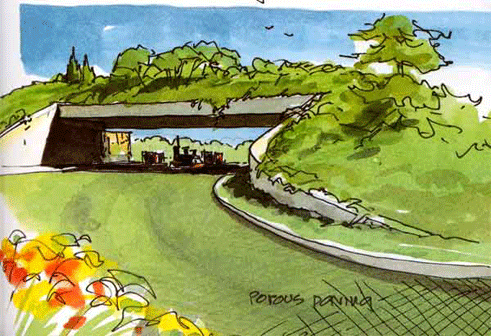The book Gentle Architecture by Malcolm Wells is one of those cult books. Published in 1981 it is out of print. The author died in 2009. But the book lives on amongst those of us searching for alternatives to our current building crisis.

Most people don’t even know we have a building crisis. Most architects don’t even know! How would they since they created the crisis in the first place. Like little foot soldiers in an unfair war they carried out their orders without question, brutalizing the landscape without moral reflection.
At the time of writing Wells had concluded that the destruction was already done. Little did he know that we as a society would continue our destructive path well into the next century. His call to change went unheeded for the most part.
And yet thirty years later I still resonate with his cry.
The book is written crudely with many non related ramblings. And Wells inability to present his thoughts in a palatable mainstream style is probably why his genius did not have a greater impact.
Despite the style, or perhaps in spite of it, his unique voice shines through like a beacon of individual conscientious humanity. It is the voice of a person speaking from their soul, as themselves, intelligently and morally. I call him the the John Muir of Architecture.
His main message is that we need to stop the way we build currently. It is destroying the world. The buildings take up too much materials to build, they destroy the land they are built on, and they consume too much energy.
His solution was a more gentle architecture of integrating the building into the surrounding landscape, usually through having all or part of the structure under ground with windows to the outside. From inside you may not even notice you are under ground but looking at the building it is substantially hidden.

This has more than visual impact. It effects the ecology of the site, the water runoff, the energy efficiency of the building, and the global impact of building.
He says that the best way to build like this is by using strong concrete, which he concedes has high embodied energy. But his view is that the tradeoff in saved energy over time is more than worth it.
As a Brooklyn green roof installer I found the book particularly interesting; it was fodder for our ongoing research and implementation of putting vegetation on Brooklyn brownstone roofs and walls.
How can we, for example, as Brooklyn green builders build an extension on a Brooklyn brownstone using Wells ideas? Instead of building the extension on the existing ground maybe we should dig down and cover the top of the extension with earth so that it looks more like a slanted garden with some windows than a square box plugged onto the back of a brownstone.


But despite the few practical discussions in the book, it is mostly a personal manifesto that he has decided to share with others. It contains his inner struggles to become a better person on this planet.
His insights are not merely of an architect seeking to do good in life but of a human seeking to do good in the universe. He writes, “I can’t begin to prove it, but I know that the more conscious we become of ourselves as riders on a lonely planet, the more quickly we’ll move toward living sanely together.”
This book is his diary of continuing consciousness and it allows us to go out and write our own diary for ourselves.
